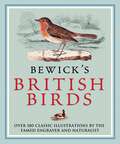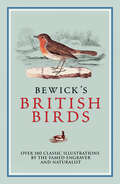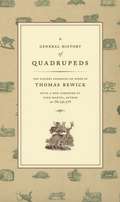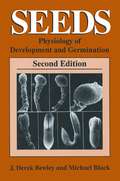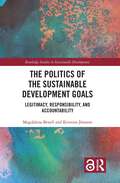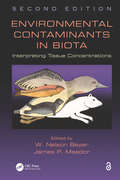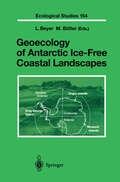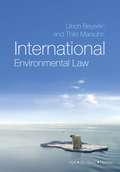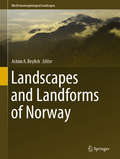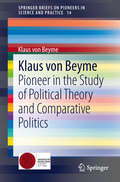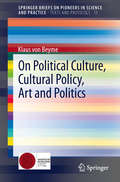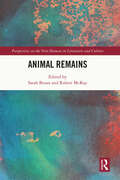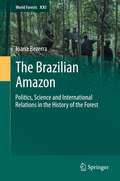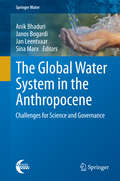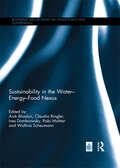- Table View
- List View
International Students in American Colleges and Universities: A History
by T. BevisA fascinating and important history of foreign students in American higher education. The book will have appeal to specialists in student services, but also to the thousands of faculty members responsible for teaching and mentoring foreign students.
Bewick’s British Birds
by Thomas BewickWith Bewick on my knee, I was then happy...' Jane EyreCharlotte Bronte's heroine was not alone in her enjoyment of Thomas Bewick's British Birds - since its first publication in 1797 it has become one of the best-loved classics of natural history. Bewick's masterful woodcuts are more than scientific records; each beady eye and jaunty pose betrays the artist's love of birds.This edition includes over 180 bird species, from garden favourites such as robins, blackbirds and finches, to predators such as the osprey and the majestic golden eagle. Each entry is illustrated with an engraving, and throughout the book are narrative vignettes typical of Bewick's playful, engaging style.
Bewick's British Birds: Over 180 Classic Illustrations by the Famed Engraver and Naturalist
by Thomas BewickWith Bewick on my knee, I was then happy...' Jane EyreCharlotte Bronte's heroine was not alone in her enjoyment of Thomas Bewick's British Birds - since its first publication in 1797 it has become one of the best-loved classics of natural history. Bewick's masterful woodcuts are more than scientific records; each beady eye and jaunty pose betrays the artist's love of birds.This edition includes over 180 bird species, from garden favourites such as robins, blackbirds and finches, to predators such as the osprey and the majestic golden eagle. Each entry is illustrated with an engraving, and throughout the book are narrative vignettes typical of Bewick's playful, engaging style.
A General History of Quadrupeds: The Figures Engraved on Wood
by Thomas BewickIn the late eighteenth century, the British took greater interest than ever before in observing and recording all aspects of the natural world. Travelers and colonists returning from far-flung lands provided dazzling accounts of such exotic creatures as elephants, baboons, and kangaroos. The engraver Thomas Bewick (1753–1828) harnessed this newfound interest by assembling the most comprehensive illustrated guide to nature of his day. A General History of Quadrupeds, first published in 1790, showcases Bewick’s groundbreaking engraving techniques that allowed text and images to be published on the same page. From anteaters to zebras, armadillos to wolverines, this delightful volume features engravings of over four hundred animals alongside descriptions of their characteristics as scientifically understood at the time. Quadrupeds reaffirms Bewick’s place in history as an incomparable illustrator, one whose influence on natural history and book printing still endures today.
A General History of Quadrupeds: The Figures Engraved on Wood
by Thomas BewickIn the late eighteenth century, the British took greater interest than ever before in observing and recording all aspects of the natural world. Travelers and colonists returning from far-flung lands provided dazzling accounts of such exotic creatures as elephants, baboons, and kangaroos. The engraver Thomas Bewick (1753–1828) harnessed this newfound interest by assembling the most comprehensive illustrated guide to nature of his day. A General History of Quadrupeds, first published in 1790, showcases Bewick’s groundbreaking engraving techniques that allowed text and images to be published on the same page. From anteaters to zebras, armadillos to wolverines, this delightful volume features engravings of over four hundred animals alongside descriptions of their characteristics as scientifically understood at the time. Quadrupeds reaffirms Bewick’s place in history as an incomparable illustrator, one whose influence on natural history and book printing still endures today.
A General History of Quadrupeds: The Figures Engraved on Wood
by Thomas BewickIn the late eighteenth century, the British took greater interest than ever before in observing and recording all aspects of the natural world. Travelers and colonists returning from far-flung lands provided dazzling accounts of such exotic creatures as elephants, baboons, and kangaroos. The engraver Thomas Bewick (1753–1828) harnessed this newfound interest by assembling the most comprehensive illustrated guide to nature of his day. A General History of Quadrupeds, first published in 1790, showcases Bewick’s groundbreaking engraving techniques that allowed text and images to be published on the same page. From anteaters to zebras, armadillos to wolverines, this delightful volume features engravings of over four hundred animals alongside descriptions of their characteristics as scientifically understood at the time. Quadrupeds reaffirms Bewick’s place in history as an incomparable illustrator, one whose influence on natural history and book printing still endures today.
A General History of Quadrupeds: The Figures Engraved on Wood
by Thomas BewickIn the late eighteenth century, the British took greater interest than ever before in observing and recording all aspects of the natural world. Travelers and colonists returning from far-flung lands provided dazzling accounts of such exotic creatures as elephants, baboons, and kangaroos. The engraver Thomas Bewick (1753–1828) harnessed this newfound interest by assembling the most comprehensive illustrated guide to nature of his day. A General History of Quadrupeds, first published in 1790, showcases Bewick’s groundbreaking engraving techniques that allowed text and images to be published on the same page. From anteaters to zebras, armadillos to wolverines, this delightful volume features engravings of over four hundred animals alongside descriptions of their characteristics as scientifically understood at the time. Quadrupeds reaffirms Bewick’s place in history as an incomparable illustrator, one whose influence on natural history and book printing still endures today.
A General History of Quadrupeds: The Figures Engraved on Wood
by Thomas BewickIn the late eighteenth century, the British took greater interest than ever before in observing and recording all aspects of the natural world. Travelers and colonists returning from far-flung lands provided dazzling accounts of such exotic creatures as elephants, baboons, and kangaroos. The engraver Thomas Bewick (1753–1828) harnessed this newfound interest by assembling the most comprehensive illustrated guide to nature of his day. A General History of Quadrupeds, first published in 1790, showcases Bewick’s groundbreaking engraving techniques that allowed text and images to be published on the same page. From anteaters to zebras, armadillos to wolverines, this delightful volume features engravings of over four hundred animals alongside descriptions of their characteristics as scientifically understood at the time. Quadrupeds reaffirms Bewick’s place in history as an incomparable illustrator, one whose influence on natural history and book printing still endures today.
A General History of Quadrupeds: The Figures Engraved on Wood
by Thomas BewickIn the late eighteenth century, the British took greater interest than ever before in observing and recording all aspects of the natural world. Travelers and colonists returning from far-flung lands provided dazzling accounts of such exotic creatures as elephants, baboons, and kangaroos. The engraver Thomas Bewick (1753–1828) harnessed this newfound interest by assembling the most comprehensive illustrated guide to nature of his day. A General History of Quadrupeds, first published in 1790, showcases Bewick’s groundbreaking engraving techniques that allowed text and images to be published on the same page. From anteaters to zebras, armadillos to wolverines, this delightful volume features engravings of over four hundred animals alongside descriptions of their characteristics as scientifically understood at the time. Quadrupeds reaffirms Bewick’s place in history as an incomparable illustrator, one whose influence on natural history and book printing still endures today.
Seeds: Physiology of Development and Germination
by J. Derek Bewley Michael BlackIn response to enormous recent advances, particularly in molecular biology, the authors have revised their warmly received work. This new edition includes updates on seed development, gene expression, dormancy, and other subjects. It will serve as the field's standard textbook and reference source for many years to come.
The Politics of the Sustainable Development Goals: Legitimacy, Responsibility, and Accountability (Routledge Studies in Sustainable Development)
by Magdalena Bexell Kristina JönssonThis book draws attention to political aspects of sustainable development goal-setting, exploring the Sustainable Development Goals (SDGs) at the global-national nexus during their first five years. After broad global deliberation and political negotiations, the 2030 Agenda and its SDGs were adopted in the United Nations (UN) General Assembly in 2015, and by now many countries have political structures in place for working towards their realisation. This book explores three concepts to call attention to the political qualities of processes related to the SDGs: legitimacy, responsibility, and accountability. Legitimacy is required to obtain broad political ownership for policy goals in order for them to become effective in addressing cross-border sustainability challenges. Responsibility needs to be clearly distributed among political institutions if a long-term set of broad goals such as the SDGs are to be realised. Accountability to the public is the retrospective mirror of political responsibility. The Politics of the Sustainable Development Goals contributes new knowledge on political processes at the nexus of global and national levels, focussing on three countries at different levels of socio-economic development and democratisation: namely Ghana, Tanzania, and Sweden. These countries illustrate a variety of challenges related to the realisation of the SDGs. This book will be of great interest to students and scholars of sustainable development, international organisations, and global politics.
The Politics of the Sustainable Development Goals: Legitimacy, Responsibility, and Accountability (Routledge Studies in Sustainable Development)
by Magdalena Bexell Kristina JönssonThis book draws attention to political aspects of sustainable development goal-setting, exploring the Sustainable Development Goals (SDGs) at the global-national nexus during their first five years. After broad global deliberation and political negotiations, the 2030 Agenda and its SDGs were adopted in the United Nations (UN) General Assembly in 2015, and by now many countries have political structures in place for working towards their realisation. This book explores three concepts to call attention to the political qualities of processes related to the SDGs: legitimacy, responsibility, and accountability. Legitimacy is required to obtain broad political ownership for policy goals in order for them to become effective in addressing cross-border sustainability challenges. Responsibility needs to be clearly distributed among political institutions if a long-term set of broad goals such as the SDGs are to be realised. Accountability to the public is the retrospective mirror of political responsibility. The Politics of the Sustainable Development Goals contributes new knowledge on political processes at the nexus of global and national levels, focussing on three countries at different levels of socio-economic development and democratisation: namely Ghana, Tanzania, and Sweden. These countries illustrate a variety of challenges related to the realisation of the SDGs. This book will be of great interest to students and scholars of sustainable development, international organisations, and global politics.
Environmental Contaminants in Biota: Interpreting Tissue Concentrations, Second Edition
by W. Nelson BeyDiscussing the interpretation of tissue concentrations of contaminants in wildlife, this updated edition of a bestseller draws on current scientific research and includes new chapters and greater emphasis on aquatic organisms. Each chapter provides a summary and review of a specific chemical along with direction on research methods and the interpretation of conflicting or insufficient data. Chapters include a comprehensive history of contaminant interpretation in wildlife and fish, the use of tissue residues in ecological risk assessment, and detailed coverage of all bioaccumulative contaminants and their physiologic affects.
I Don’t Really Love You: And Other Gentle Reminders Of Existential Dread In Your Everyday Life
by Alex BeyerGo from aww to awful! with I Don't Really Love You, a darkly humorous collection of adorable pet photography and soul-crushing one-liners, based on the popular Instagram @365DaysofDread. Drawing on the black humor of author Alex Beyer, I Don't Really Love You takes readers on a journey from delightful to depressing (and back again!). Dead pan captions, from "Birthdays don't matter" to "Inadequacy haunts me endlessly," peek out from behind the forms of calm cats and happy-go-lucky puppies, creating an unexpected contrast and offbeat appeal. Pet lovers and humor lovers will be captivated in equal measure, with more than 75 full-color photographs of cats and dogs in a range of breeds, alongside an off-beat, subversive voice. With the perfect attitude for our rapidly changing world, this quirky book will make readers laugh out loud (after sending them crawling under the covers to contemplate their existence).
Geoecology of Antarctic Ice-Free Coastal Landscapes (Ecological Studies #154)
by L Beyer M. BölterResearch in Antarctica in the past two decades has fundamentally changed our perceptions of the southern continent. This volume describes typical terrestrial environments of the maritime and continental Antarctic. Life and chemical processes are restricted to small ranges of ambient temperature, availability of water and nutrients. This is reflected not only in life processes, but also in those of weathering and pedogenesis. The volume focuses on interactions between plants, animals and soils. It includes aspects of climate change, soil development and biology, as well as above- and below-ground results of interdisciplinary research projects combining data from botany, zoology, microbiology, pedology, and soil ecology.
Environmental Contaminants in Biota: Interpreting Tissue Concentrations, Second Edition
by W. Nelson Beyer James P. MeadorExamining tissue residues of contaminants in biota reveals the movement of contaminants within organisms and through food chains as well as the context for understanding and quantifying injuries to organisms and their communities. Yet tissue concentrations of some contaminants are especially challenging to interpret and the ability of today's analy
International Environmental Law
by Ulrich Beyerlin Thilo MarauhnInternational Environmental Law is a new textbook written for students, practitioners, and anyone interested in the subject. The overall aim of the book is to provide a fresh understanding of international environmental law as a whole, seen in the light of climate change, biodiversity loss, and the other serious environmental challenges facing the world. The book has also been kept deliberately manageable in size by careful selection of topics and by adopting a cross-cutting synthesis of regulatory interaction in the field. This enables the reader to place international environmental law in the broader context of public international law in general, revealing at the same time that international environmental law is experimental ground for developing new legal approaches towards global governance. To this end, the authors have combined theory and practice.Apart from discussing concepts, rule-making and compliance, the book looks at options for improved coordination, harmonisation and even integration of existing multilateral environmental agreements, analysing how conflicts between various environmental regimes can be avoided or, at least, adequately managed. The authors argue that an appropriate management of international environmental relations must address the North-South divide, which continues to be a major obstacle to global environmental cooperation. Furthermore, the authors emphasise the growing human rights dimension of international environmental law.This book is an ideal 'door opener' for the further study of international environmental law. Focusing on 'international environmental governance' in a comprehensive way, it serves to explain that each institution, each actor, and each instrument is part of a multi-dimensional process in international environmental law and relations.
Landscapes and Landforms of Norway (World Geomorphological Landscapes)
by Achim A. BeylichThis book discusses the striking geomorphological landscapes of mainland Norway. As part of the Springer book series on World Geomorphological Landscapes, it outlines the nature and diversity of Norway's geomorphological landscapes and examines the geological background and the drivers of landscape evolution. It also features numerous case studies describing the most striking sites, and offers insights into the status and value of geoheritage and geoconservation in the country.Providing readers with an opportunity to explore the variety of Norwegian landscapes and landforms through informative texts richly illustrated with color maps and photos, the book will appeal to scientists, scholars and any readers interested in geology, physical geography, geomorphology, landscape tourism, geoheritage and environmental protection.
Klaus von Beyme: Pioneer in the Study of Political Theory and Comparative Politics (SpringerBriefs on Pioneers in Science and Practice #14)
by Klaus BeymeKlaus von Beyme, a highly distinguished German political scientist, has been recognised as a “Pioneer in the Study of Political Theory and Comparative Politics”. When he received the highly esteemed Mattei Dogan Award during the XXII World Congress of Political Science in Madrid on 12 July 2012, in his laudatio Rainer Eisfeld portrayed Klaus v. Beyme as a “Global Scholar and Public Intellectual”. On the occasion of Klaus v. Beyme’s 80th birthday this book offers a selection of his major previously published and new texts focusing on “Empirical Political Theory”, “The Evolution of Comparative Politics, Revival of Normative Political Theory in Empirical Research”, “Theodor W. Adorno - Political Theory as Theory of Aesthetics”, “Historical Forerunners of Policy Studies”, “Political Institutions – Old and New”, “Representative Democracy and the Populist Temptation”, “Political Advisors to Politicians”, and on “The Concept of Political Class: A New Dimension of Research on Elites?”.
On Political Culture, Cultural Policy, Art and Politics (SpringerBriefs on Pioneers in Science and Practice #15)
by Klaus BeymeKlaus von Beyme is a distinguished German political scientist and recipient of the Mattei Dogan Award of Political Science (2012). In honour of his 80th birthday this book addresses political culture, cultural policy, art and politics. The first part on transformation theory analyses: “Historical Memories in Political Theories”, “Historical Memory in Nation-Building and the Building of Ethnic Subsystems”, “The Concept of Totalitarianism – A Reassessment After the Breakdown of Soviet Rule”, “Political Culture – A Concept from Ideological Refutation to Acceptance in the Soviet Social Sciences”, “Institutions and Political Culture in Post-Soviet Russia” and “Political and Economic Consolidation in Eastern Europe. Evidence from Empirical Data”. The second part on cultural policies addresses “Why is There No Political Science of the Arts?”, “Historical Memory and the Arts in the Era of the Avantgardes: Archaisme and Passéisme as a ‘passéisme of the future’”, and “Capital-building in Post-war Germany”.
Animal Remains (Perspectives on the Non-Human in Literature and Culture)
by Sarah Bezan Robert McKayThe dream of humanism is to cleanly discard of humanity’s animal remains along with its ecological embeddings, evolutionary heritages and futures, ontogenies and phylogenies, sexualities and sensualities, vulnerabilities and mortalities. But, as the contributors to this volume demonstrate, animal remains are everywhere and so animals remain everywhere. Animal remains are food, medicine, and clothing; extractive resources and traces of animals’ lifeworlds and ecologies; they are sites of political conflict and ontological fear, fetishized visual signs and objects of trade, veneration and memory; they are biotechnological innovations, and spill-over viruses. To make sense of the material afterlives of animals, this book draws together multispecies perspectives from literary criticism and theory, cultural studies, anthropology and ethnography, photographic and film history, and contemporary art practice to offer the first synoptic account of animal remains. Interpreting them in all their ubiquity, diversity and persistence, Animal Remains reveals posthuman relations between human and nonhuman communities of the living and the dead, on timescales of decades, centuries, and millennia.
Animal Remains (Perspectives on the Non-Human in Literature and Culture)
by Sarah Bezan Robert McKayThe dream of humanism is to cleanly discard of humanity’s animal remains along with its ecological embeddings, evolutionary heritages and futures, ontogenies and phylogenies, sexualities and sensualities, vulnerabilities and mortalities. But, as the contributors to this volume demonstrate, animal remains are everywhere and so animals remain everywhere. Animal remains are food, medicine, and clothing; extractive resources and traces of animals’ lifeworlds and ecologies; they are sites of political conflict and ontological fear, fetishized visual signs and objects of trade, veneration and memory; they are biotechnological innovations, and spill-over viruses. To make sense of the material afterlives of animals, this book draws together multispecies perspectives from literary criticism and theory, cultural studies, anthropology and ethnography, photographic and film history, and contemporary art practice to offer the first synoptic account of animal remains. Interpreting them in all their ubiquity, diversity and persistence, Animal Remains reveals posthuman relations between human and nonhuman communities of the living and the dead, on timescales of decades, centuries, and millennia.
The Brazilian Amazon: Politics, Science and International Relations in the History of the Forest (World Forests #21)
by Joana BezerraThe aim of this book is to analyse the current development scenario in the Amazon, using Terra Preta de Índio as a case study. To do so it is necessary to go back in time, both in the national and international sphere, through the second half of the last century to analyse its trajectory. It will be equally important analyse the current issues regarding the Amazon – sustainable development and climate change – and how they still reproduce some of the problems that marked the history of the forest, such as the absence of Amazonian dark earths as a relevant theme to the Amazon.In a world in which the environment gains each time more space in the national and international political agenda, the Amazon stands out. Known around the world for its richness, the South-American forest is the target of different visions, often contradictory ones, and it plays with everyone’s imagination. This is where the terra preta de índio – Amazonian Dark Earths - are found, a fertile soil horizon with high concentrations of carbon with anthropic origins, which has generated great interest from the scientific community. Studies on these soils and their so singular characteristics have triggered crucial discussions on the past, present and the future of the entire Amazon region. Despite its singular characteristics, the importance of Amazonian Dark Earths – and a history of a more productive and populated Amazon – was hidden since its discovery around 1880 until 1980, when it is possible to identify the beginning of an increase in the number of research on these soil horizons. These hundred years between the first records and the beginning of the increase in the interest around these soils witnessed structural changes both in the national arena, with the military dictatorship and a change in the place of the Amazon within internal affairs, and in the international arena with changes that reshaped the role of the environment in the political and scientific agendas and the role of Brazil in the global context.
The Global Water System in the Anthropocene: Challenges for Science and Governance (Springer Water)
by Anik Bhaduri Janos Bogardi Jan Leentvaar Sina MarxThe Global Water System in the Anthropocene provides the platform to present global and regional perspectives of world-wide experiences on the responses of water management to global change in order to address issues such as variability in supply, increasing demands for water, environmental flows and land use change. It helps to build links between science and policy and practice in the area of water resources management and governance, relates institutional and technological innovations and identifies in which ways research can assist policy and practice in the field of sustainable freshwater management. Until the industrial revolution, human beings and their activities played an insignificant role influencing the dynamics of the Earth system, the sum of our planet‘s interacting physical, chemical, and biological processes. Today, humankind even exceeds nature in terms of changing the biosphere and affecting all other facets of Earth system functioning. A growing number of scientists argue that humanity has entered a new geological epoch that needs a corresponding name: the Anthropocene. Human activities impact the global water system as part of the Earth system and change the way water moves around the globe like never before. Thus, managing freshwater use wisely in the planetary water cycle has become a key challenge to reach global environmental sustainability.
Sustainability in the Water-Energy-Food Nexus (Routledge Special Issues on Water Policy and Governance)
by Anik Bhaduri Claudia Ringler Ines Dombrowsky Rabi Mohtar Waltina ScheumannIt is beyond doubt that the interconnectedness between food, energy, water security and environmental sustainability exists and is getting amplified with increased globalization. It has been recognized that efforts to address only one part of a systemic problem by neglecting other inherently interlinked aspects may not lead to desirable and sustainable outcomes. In this perspective, policy- and decision- making requires a nexus approach that reduces trade-offs and builds synergies across sectors, and helps to reduce costs and increase benefits for humans and nature compared to independent approaches to the management of water, energy, food and the environment. In the past, work related to the Nexus has looked at the interactions between water and food or water and energy, but there has been a reluctance to bring forward a broader systematic perspective that captures the multiple sectors and resource dependencies while understanding its cost to the environment if we neglect these linkages. This book is a compilation of thirteen papers published previously as a special issue of Water International, contains significant pieces of work on the W-E-F nexus focusing on relevant tools, solutions and governance at local and broader human scales.

